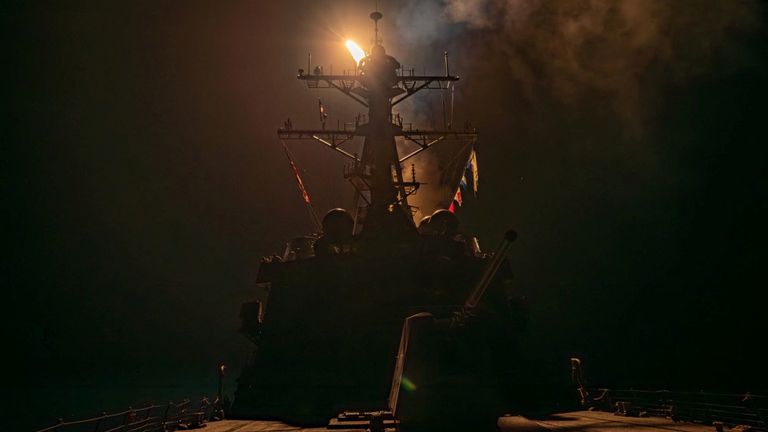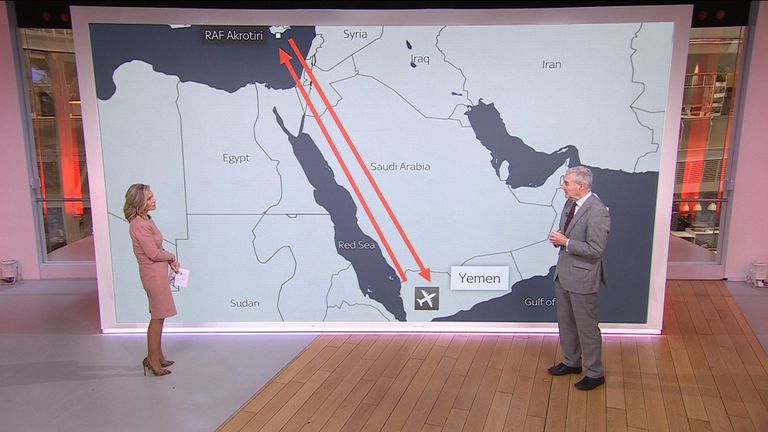Despite an international coalition providing a protective umbrella over the Red Sea – Op Prosperity Guardian – the Houthi attacks against merchant shipping continued.
Shortly before midnight on Thursday, the US and UK launched a wave of attacks on 60 Houthi military targets using over 100 guided munitions, predominantly Tomahawk cruise missiles.
The UK contribution to the strike package was four Typhoon fighter jets.
Although cruise missiles can be launched from hundreds of miles away from their targets, once launched they can take some time to reach them and, while en route, the ground situation can change.
Fighter missions place the pilots in harm’s way, but also enable a much shorter time-of-flight for the weapon, and thus a more dynamic assessment to be made of the threat and potential collateral damage.
So, what is involved in mounting a Typhoon attack mission?
From the moment that the Houthis started attacking Red Sea merchant shipping on 19 November, US and UK forces would have been developing a suitable list of military targets and options.
Satellite imagery and routine intelligence gathering would have identified command and control nodes, radars, weapon storage areas and missile launch sites, plus established “pattern of life” around potential targets to assess the risks of collateral damage.
Diplomatic options ‘exhausted’
Once the two countries’ political leadership had exhausted diplomatic options, they would have outlined what they wanted any military action to achieve, and be briefed on options.
The political objective was to avoid further escalation, demonstrate resolve, and degrade the Houthis’ capability to attack shipping, but limit collateral damage.
The US appears to have identified a window of opportunity to conduct strikes – overnight to limit the number of casualties – and the UK PM approved the military action.
The Typhoon capability already deployed to Cyprus would have received their tasking several hours before launch, prompting an intense period of planning and preparation.
Pilots planning routes, weapons specialists matching weapons to targets – size of bomb, fusing, guidance required – and deciding which pilots would be selected for the mission.
In addition, the whole squadron would have been focused on preparing the four aircraft, refuelling, and arming, servicing and downloading vital software – a team effort.
But Cyprus is a long way from the target area – a round trip of more than 3,000 miles. Two air-to-air refuelling tankers (Voyager) would also be required to refuel the Typhoons both before entering Yemeni airspace, and also to provide the vital top-up to get the jets home again.
Planning these sorties takes time, co-ordination and patience.
Working back from the planned Time on Target – co-ordinated with the US strikes occurring simultaneously – the pilots would identify where the tanker needed to be, and when, and with how much fuel, for both ingress and egress.
The pilots can then work out their departure time from Cyprus, before which they need to conduct pre-flight briefings, get kitted out in flight gear, walk to jets leaving time to race for the spare jet if the primary fails to start – and getting briefed on the recovery plan should the pilot get shot down over Yemen.
Jets ‘bristling with arms’
Walking out to the jets focuses the mind – seeing the Typhoon jet bristling with live missiles and explosive munitions is a stark reminder that this is no training mission.
Finding the refuelling tanker can often be a challenge – especially if the weather is less than fair – but plugging in at over 20,000 ft (6,100m) and seeing the fuel gauge read full again, it’s time to depart the sanctuary of international airspace and plot a course to the target.
Defensive aids on, chaff and flares ready, watching for any signs that enemy radars are tracking you.
Click to subscribe to the Sky News Daily wherever you get your podcasts
Handheld Houthi missiles and bullets are a threat, but flying above 10,000 ft (3,000m) limits their effectiveness.
Approaching the target, the adrenalin is surging, and pilots must avoid getting distracted by other US munitions impacting their targets.
Read more:
Explainer – the comparisons with WWII and IS fight
How British warship repelled Houthi attack
Who are the Houthis?
Explainer – why the UK and US struck Houthi targets
A second rendezvous with the tanker to fill up again, and then the long flight back home.
Land, sign in the jet, get out of the immersion suit, g-suit and other flying kit, go to the bathroom, rehydrate, then prepare for an hour-long debrief.
And for the ground crew, armourers, suppliers and support staff, the work starts all over again.
A simple headline like “UK Typhoons strike Houthi targets”, requires an immense effort behind the scenes, and it’s a superb example of British experience, professionalism, and teamwork.




